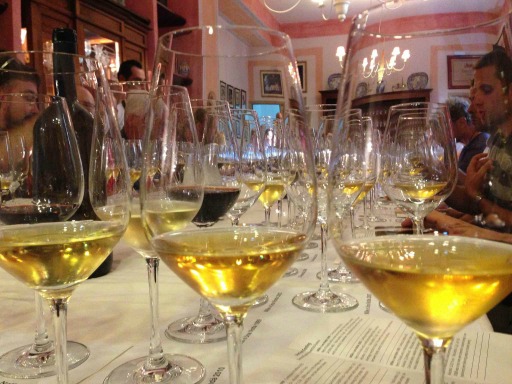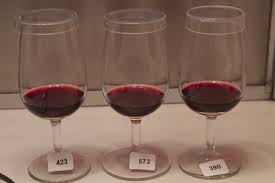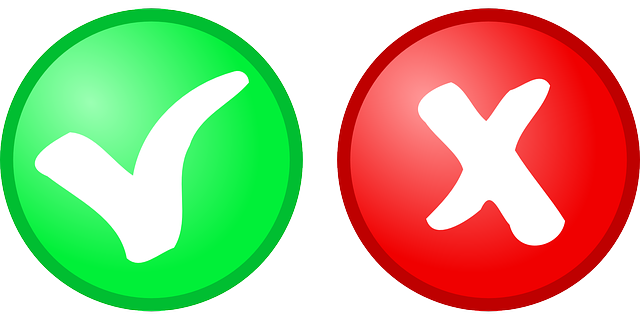Can wine experts identify wine oxidation better than novices?
Wine oxidation is an insidious phenomenon and not easily identified, even by wine professionals. Here is a true story.

My colleague and I were invited to a wine tasting dinner, hosted in one of the most famous winery restaurants of the region. A dozen of winemakers and wine journalists were seated at the dinner table, and the two of us, sensory scientists.
Can one be so blind to wine oxidation?
One of the guests had brought a bottle of Chardonnay he had produced a few years back, for everyone to enjoy with the tasting menu. As soon as I smelled the wine in my glass, I identified some honey notes and sherry-like notes; in mouth, the wine was very thin, even bitter; clearly this wine had a defect and I thought, “hmm…oxidized?” I looked at my colleague and whispered, “Isn’t it oxidized?” And she replied softly, “Yes, it is”. But it was too late to voice our perceptions as all the guests were raving on how wonderful and pleasing this wine was. We didn’t want to be disrespectful of our host and listened to all the great qualities the others were commenting on as they were tasting this aged Chardonnay.
Yes, oxidation is a wine aging character. As the wine sits in the bottle, it will slowly oxidize over time, the ambient oxygen permeating through the cork. This slow oxidation usually forms aromas imparted by compounds chemists call aldehydes. When these compounds reach high levels in the wine, they turn into wine faults.
Were we too sensitive to wine oxidation?......Or was something else going on?
Recent research on wine oxidation comes handy
I found some answers in the article published recently by Franco-Luesma et collaborators, entitled “Oxidation in wine: Does expertise influence the perception?”
Their hypothesis was that wine experts would identify oxidation as a default in wine at a lower concentration than novices would. Experts through their formal wine education, wine tasting training, and professional experience should have formed a clear mental image of what wine oxidation is, when it is desirable (like in Sherry) and when it is a fault.
The experiment
So the researchers designed an experiment that was conducted in France, in the Beaujolais region.They selected one red wine, a 2015 Côtes du Rhône, that was a blend made from Grenache and Syrah grapes, and a 2016 Chardonnay from the Loire Valley.
These wines were default free and the researchers created 12 wine samples, by spiking each wine with increasing doses of the 3 compounds responsible for imparting oxidized aromas in wine.
They invited 29 wine experts from the Beaujolais region and recruited 32 wine novices, who were of legal age for drinking alcohol, drank wine at least once a month, and who had never taken a formal wine appreciation course.
These two groups, experts and novices, were invited to two-20 minute sensory sessions.

In each session, they were presented a set of 12 wine glasses, each containing one of the spiked samples. Half of the tasters started by evaluating the 12 white samples and the other half started with the 12 red wine samples. The wines were presented in a predefined order, from the lowest concentration of oxidation notes to the highest.
The task was simple.
“Imagine you are hosting friends for dinner. You just opened this bottle of wine and you smell it before pouring. These wines are from the Côtes du Rhône (red wine samples)/Loire Valley (white wine samples) and cost 7 euros a bottle. Would you serve this wine to your friends?”

Yes (no fault) or No (faulty).
They were told they could also offer free comments.
The data collected were simple: for each spiked wine sample, a taster was responding yes or no, and was providing a list of terms that could be descriptive or hedonic (linked to their likes or dislikes).
The results
The results were surprising.
While the 29 experts showed somewhat more consensus than the novices when they were categorizing the wines as faulty/not faulty, they didn’t seem more sensitive. There were no clear indication that they could identify wine oxidation at a lower level than the wine novices.
Wine experts generated more descriptive terms than the novices, as was expected from previous research, however it didn’t help them identify the wine fault earlier in the 12 sample series.
The researchers then looked at the response pattern of each taster for the 12 samples. Did they answer randomly, was there a concentration threshold after which all the wines were classified faulty?
Actually the researchers found 5 different patterns they labelled behaviors.
Behavior A: The tasters experienced a clear categorization; after reaching a certain wine oxidation level, the following samples were classified faulty. That’s what you would expect from wine experts, right?
Behavior B: The tasters almost got a clear categorization with some hesitation at the beginning, but they classified the following samples as faulty.
Behavior C: The tasters were more hesitant until they reached a wine oxidation level for which they were clearly confident wines were faulty.
Behavior D: These tasters didn’t seem to reject oxidized wines. On the contrary, the more oxidized, the less faulty. That is unexpected, especially because Chardonnays are not meant to be drunk oxidized contrarily to Xeres wine or Vin Jaune from the Jura region.
Behavior E: These tasters gave random responses once faulty, once non faulty, indicating that these tasters were not recognizing the fault in the wines.
Interestingly, the experts and novices were not different in expressing these different behaviors.
Here is a possible answer to our oxidized wine situation
Ha Ha! Thinking back on the winery dinner, maybe my colleague and I misunderstood the wine style the winemaker wanted to produce and all the other guests were expressing Behavior D.
They were all fans of wine oxidation!
Reference
Ernesto Franco-Luesma, Carole Honoré-Chedozeau, Jordi Ballester, Dominique Valentin. 2019. LWT, Volume 116,2019, 108511. Oxidation in wine: Does expertise influence the perception?
Published August 28, 2019

